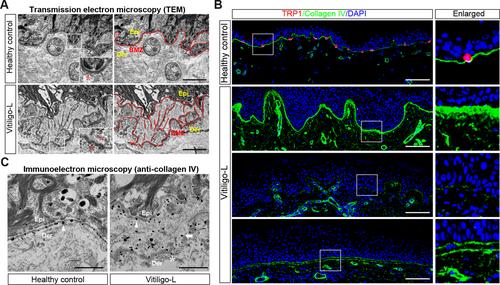Disorganisation of basement membrane zone architecture impairs melanocyte residence in vitiligo
Fei Yang, Lingli Yang, Yasutaka Kuroda, Sylvia Lai, Yoshito Takahashi, Tetsuya Sayo, Takeshi Namiki, Kimiko Nakajima, Shigetoshi Sano, Shintaro Inoue, Daisuke Tsuruta, Ichiro Katayama
下载PDF
{"title":"Disorganisation of basement membrane zone architecture impairs melanocyte residence in vitiligo","authors":"Fei Yang, Lingli Yang, Yasutaka Kuroda, Sylvia Lai, Yoshito Takahashi, Tetsuya Sayo, Takeshi Namiki, Kimiko Nakajima, Shigetoshi Sano, Shintaro Inoue, Daisuke Tsuruta, Ichiro Katayama","doi":"10.1002/path.6321","DOIUrl":null,"url":null,"abstract":"<p>The basement membrane zone is the interface between the epidermis and dermis, and it is disrupted in several skin conditions. Here, we report the results of a comprehensive investigation into the structural and molecular factors of the basement membrane zone in vitiligo, a dermatological disorder characterised by depigmented patches on the skin. Using electron microscopy and immunofluorescence staining, we confirmed abnormal basement membrane zone morphology and disrupted basement membrane zone architecture in human vitiliginous skin. Furthermore, we identified elevated expression of matrix metalloproteinase 2 (MMP2) in human dermal fibroblasts as a key factor responsible for basement membrane zone matrix degradation. In our <i>in vitro</i> and <i>ex vivo</i> models, overexpression of MMP2 in fibroblasts led to basement membrane zone disruption and melanocyte disappearance. Importantly, we reveal that the loss of melanocytes in vitiligo is primarily linked to their weakened adhesion to the basement membrane, mediated by binding between integrin β1 and laminin and discoidin domain receptor 1 and collagen IV. Finally, inhibition of matrix metalloproteinase 2 expression reversed depigmentation in a mouse model of vitiligo. In conclusion, our research shows the importance of basement membrane zone integrity in melanocyte residence and offers new avenues for therapeutic interventions to address this challenging skin condition. © 2024 The Author(s). <i>The Journal of Pathology</i> published by John Wiley & Sons Ltd on behalf of The Pathological Society of Great Britain and Ireland.</p>","PeriodicalId":232,"journal":{"name":"The Journal of Pathology","volume":"264 1","pages":"30-41"},"PeriodicalIF":5.6000,"publicationDate":"2024-07-11","publicationTypes":"Journal Article","fieldsOfStudy":null,"isOpenAccess":false,"openAccessPdf":"https://onlinelibrary.wiley.com/doi/epdf/10.1002/path.6321","citationCount":"0","resultStr":null,"platform":"Semanticscholar","paperid":null,"PeriodicalName":"The Journal of Pathology","FirstCategoryId":"3","ListUrlMain":"https://onlinelibrary.wiley.com/doi/10.1002/path.6321","RegionNum":2,"RegionCategory":"医学","ArticlePicture":[],"TitleCN":null,"AbstractTextCN":null,"PMCID":null,"EPubDate":"","PubModel":"","JCR":"Q1","JCRName":"ONCOLOGY","Score":null,"Total":0}
引用次数: 0
引用
批量引用
Abstract
The basement membrane zone is the interface between the epidermis and dermis, and it is disrupted in several skin conditions. Here, we report the results of a comprehensive investigation into the structural and molecular factors of the basement membrane zone in vitiligo, a dermatological disorder characterised by depigmented patches on the skin. Using electron microscopy and immunofluorescence staining, we confirmed abnormal basement membrane zone morphology and disrupted basement membrane zone architecture in human vitiliginous skin. Furthermore, we identified elevated expression of matrix metalloproteinase 2 (MMP2) in human dermal fibroblasts as a key factor responsible for basement membrane zone matrix degradation. In our in vitro and ex vivo models, overexpression of MMP2 in fibroblasts led to basement membrane zone disruption and melanocyte disappearance. Importantly, we reveal that the loss of melanocytes in vitiligo is primarily linked to their weakened adhesion to the basement membrane, mediated by binding between integrin β1 and laminin and discoidin domain receptor 1 and collagen IV. Finally, inhibition of matrix metalloproteinase 2 expression reversed depigmentation in a mouse model of vitiligo. In conclusion, our research shows the importance of basement membrane zone integrity in melanocyte residence and offers new avenues for therapeutic interventions to address this challenging skin condition. © 2024 The Author(s). The Journal of Pathology published by John Wiley & Sons Ltd on behalf of The Pathological Society of Great Britain and Ireland.
基底膜区结构的紊乱会影响白癜风中黑色素细胞的驻留。
基底膜区是表皮和真皮之间的界面,它在多种皮肤病中受到破坏。在此,我们报告了对白癜风基底膜区的结构和分子因素进行全面研究的结果,白癜风是一种以皮肤色素脱失斑为特征的皮肤病。通过电子显微镜和免疫荧光染色,我们证实了人类白癜风皮肤基底膜区形态异常和基底膜区结构紊乱。此外,我们还发现人真皮成纤维细胞中基质金属蛋白酶 2 (MMP2) 的表达升高是导致基底膜区基质降解的关键因素。在我们的体外和体内模型中,成纤维细胞过量表达 MMP2 会导致基底膜区破坏和黑色素细胞消失。重要的是,我们发现白癜风中黑色素细胞的消失主要与它们对基底膜的粘附力减弱有关,这种粘附力是通过整合素β1和层粘连蛋白以及盘状蛋白结构域受体1和胶原蛋白IV之间的结合来介导的。最后,抑制基质金属蛋白酶 2 的表达可逆转小鼠白癜风模型中的脱色。总之,我们的研究显示了基底膜区完整性对黑色素细胞驻留的重要性,并为治疗干预提供了新的途径,以解决这一具有挑战性的皮肤问题。© 2024 作者。病理学杂志》由约翰威利父子有限公司代表大不列颠及爱尔兰病理学会出版。
本文章由计算机程序翻译,如有差异,请以英文原文为准。



